Food and Drink: Did You Know?
Sweet TreatDulce de leche (meaning "sweet [made] of milk") is a thick, creamy caramel sauce that is a popular Mexican dessert topping. It can be made easily at home by submerging a can of sweetened condensed milk in boiling water and simmering it for two to three hours. ▶ |
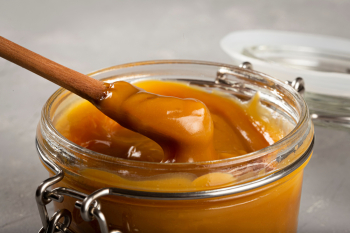 |
Nopal CactusMexico is known for its culinary use of the nopal cactus, also known as prickly pear. Nopal is a versatile ingredient used in salads, tacos, stews, and even juices. It is prized for its nutritional benefits, including high fiber content and antioxidants. Nopal adds a slightly tart flavor and a crunchy texture to dishes, contributing to its popularity in Mexican cuisine. ▶ |
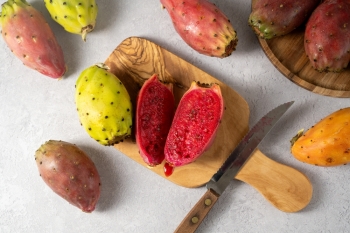 |
Born of CornMexican culture is so steeped in its unique food history that the Maya origin myth teaches that the gods created humans from masa, a type of corn dough. They fashioned four women and four men out of masa, and from the union of these four couples the lineage of the Maya people descended. ▶ |
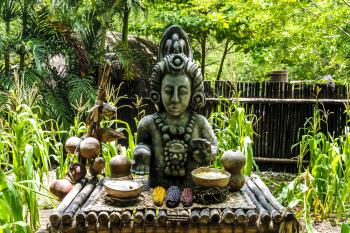 |
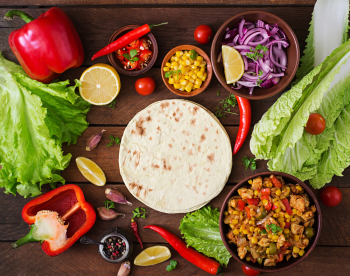 |
New World Origins◀ Modern cooking around the globe owes a great debt to Mexican cuisine. Many beloved foods and flavors essential to everyday cooking—among them tomatoes, avocados, chili peppers, corn, and chocolate—all originated in Mexico. Excepting corn, the names of these foods are based on words from the indigenous Nahuatl language spoken by the Aztecs. |
Tamale WrappersTamales are a staple in Mexican cuisine, but different regions prepare them in different ways. In Southern Mexico, banana leaves are preferred as they are abundant. They impart a distinct herbal flavor and aroma to the tamales, adding to the complexity of the dish. They also keep the tamales moist during steaming. In Central and Northern Mexico, corn husks are typically used, due to both tradition and availability. Corn husks provide a sturdy wrapper and add a subtle earthy flavor to the masa (dough) and filling inside. ▶ |
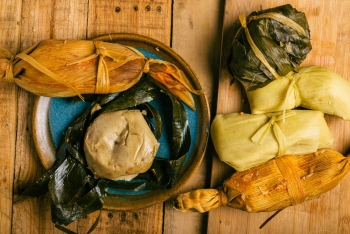 |
Ancient AmaranthAmaranth, a grain, was one of the major staple crops of the Aztec diet and was used to make a variety of dishes, including tamales, atole (a traditional beverage), and tortillas. Amaranth also played a crucial role in Aztec religious ceremonies. When the Spanish arrived in the 16th century, they were disturbed by the religious practices involving amaranth and sought to suppress the crop to weaken the cultural and religious fabric of the Aztecs. The cultivation of amaranth was banned, and fields were destroyed. However, the resilient crop survived in isolated regions and was eventually revived as a valuable food source. Today, amaranth is recognized as a superfood due to its exceptional nutritional profile. In Mexico, it is commonly used in traditional sweets such as alegrías, which are made by mixing popped amaranth seeds with honey or syrup. ▶ |
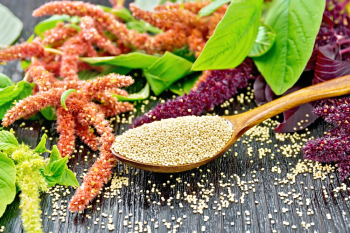 |
Day of the Dead OfferingsDuring Mexico's Día de los Muertos (Day of the Dead) celebrations, families create elaborate ofrendas (altars) to honor deceased loved ones. These altars are adorned with marigolds, candles, sugar skulls, and the deceased's favorite foods and drinks, including pan de muerto ("bread of the dead") and mole. ▶ |
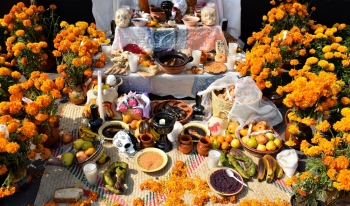 |
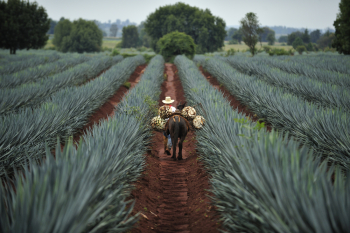 |
Agave Alcohol◀ The agave plant is the source of several classic Mexican spirits. Tequila is produced mainly in the state of Jalisco and must come from the blue agave plant, while mezcal can be made from various agave species and is traditionally produced in Oaxaca. Pulque is an alcoholic beverage made from fermented agave sap. It is traditionally associated with central Mexico, particularly with the regions around Mexico City and the states of Hidalgo, Tlaxcala, and Puebla. Pulque was considered a sacred beverage by the Aztecs and was consumed during religious ceremonies and celebrations. It has a slightly viscous consistency and a tangy flavor, and it is often flavored with fruits or herbs. |
Corn DiversityMexico is the center of origin and diversity for corn, known in Spanish as maíz. There are hundreds of varieties of corn in Mexico, each with its own unique flavor and texture, used in dishes such as tortillas, tamales, and pozole. Traditional varieties of corn are crucial to Mexican cuisine and culture. ▶ |
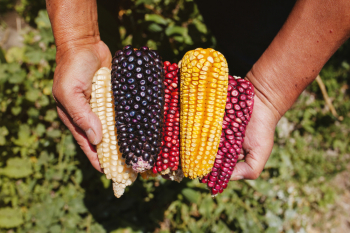 |
Eastern OriginTacos al pastor, a quintessential Mexican street food, has roots in Middle Eastern cuisine. Lebanese immigrants brought the technique of cooking meat on a vertical spit (similar to shawarma) to Mexico, where it evolved into the marinated pork dish we know today, served with pineapple, cilantro, and onion. ▶ |
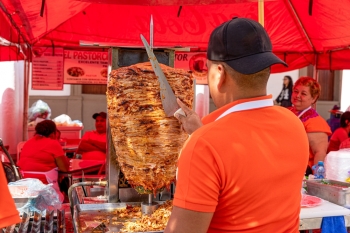 |
Protein-PackedInsects have been a traditional part of Mexican cuisine for centuries. Grasshoppers, called chapulines, are a popular snack in regions such as Oaxaca. Often roasted with garlic, lime, and salt, they have a crunchy texture and a nutty, earthy flavor. They are a common street food and are enjoyed as a protein-rich treat. ▶ |
 |
 |
Holy Mole!◀ Mexico boasts more than seven types of mole, a rich, complex sauce made with ingredients such as chile peppers, nuts, seeds, spices, bread, and chocolate. Mole poblano is the most famous variety, originating from the city of Puebla, and is known for its deep, earthy flavors that complement dishes such as chicken or enchiladas. |
Street PizzasTlayudas are a specialty of Oaxaca, often referred to as "Mexican pizza." They consist of a large, thin, crispy tortilla topped with refried beans, Oaxacan cheese, lettuce, avocado, salsa, and a choice of meat (such as tasajo or chorizo). Tlayudas are cooked on a comal (griddle) and are a popular street food. ▶ |
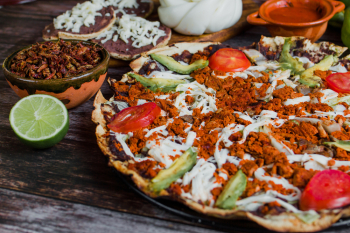 |
Birth of a BeverageMexico is the birthplace of chocolate. The ancient Mesoamericans, particularly the Aztecs and Mayans, were the first to cultivate cacao plants and create chocolate beverages. They used a mixture of ground cacao beans, water, chili peppers, and other spices to make a frothy, bitter drink, xocolatl, that was prized for its stimulating properties. This beverage was believed to have divine properties and was often consumed by priests and nobles. The Aztecs considered cacao beans so valuable that they used them as currency. For example, a turkey hen could be purchased for 100 cacao beans, and a single bean could buy a tamale. Cacao beans were also used in religious ceremonies and as offerings to gods. ▶ |
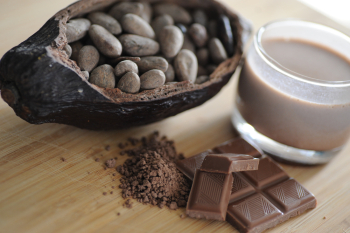 |
Tex-MexMexican-inspired food eaten in the United States is called Tex-Mex cuisine and is a remnant of the historic cultural and political geography of the American Southwest, once a part of Mexico. It developed in Texas as Mexican immigrants adapted their traditional recipes to the ingredients available in the region and incorporated elements of American cuisine. Tex-Mex cuisine often incorporates ingredients not commonly found in traditional Mexican dishes, such as yellow cheese (for example, cheddar or Monterey Jack), ground beef, cumin, and wheat flour tortillas. It also tends to be bolder and spicier, with a heavier use of spices such chili powder and cumin. Tex-Mex cuisine has its own iconic dishes that are less common in traditional Mexican cuisine, such as chili con carne (a meat and chili pepper stew), nachos (tortilla chips topped with cheese and jalapeños), and fajitas (grilled meat served with tortillas and toppings). ▶ |
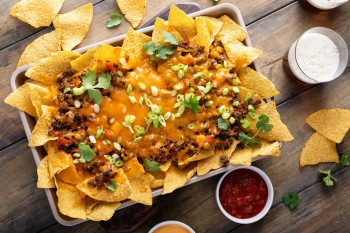 |
Copyright © 1993—2024 World Trade Press. All rights reserved.

 Mexico
Mexico